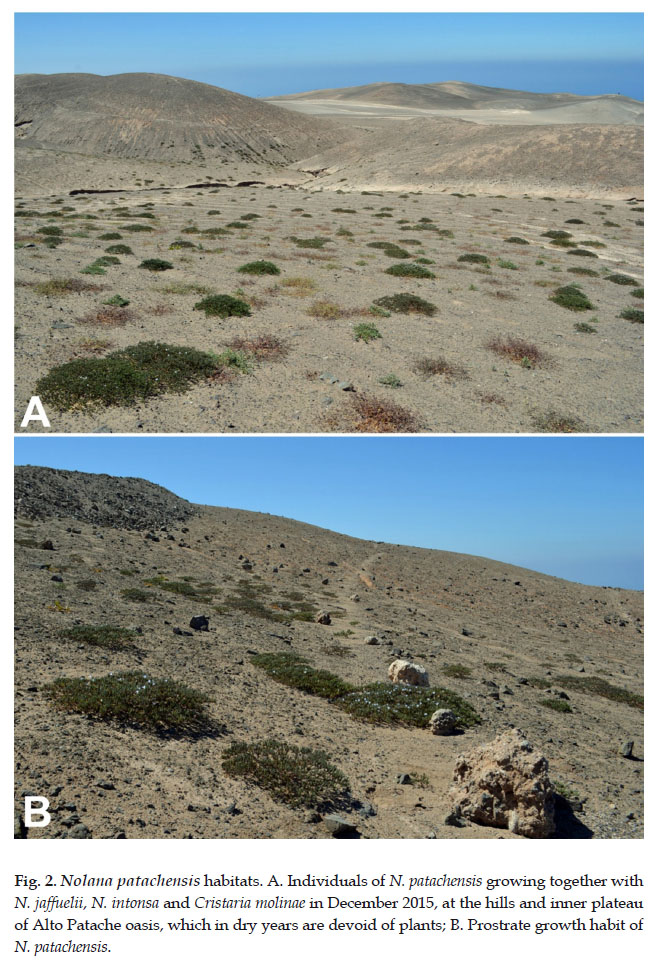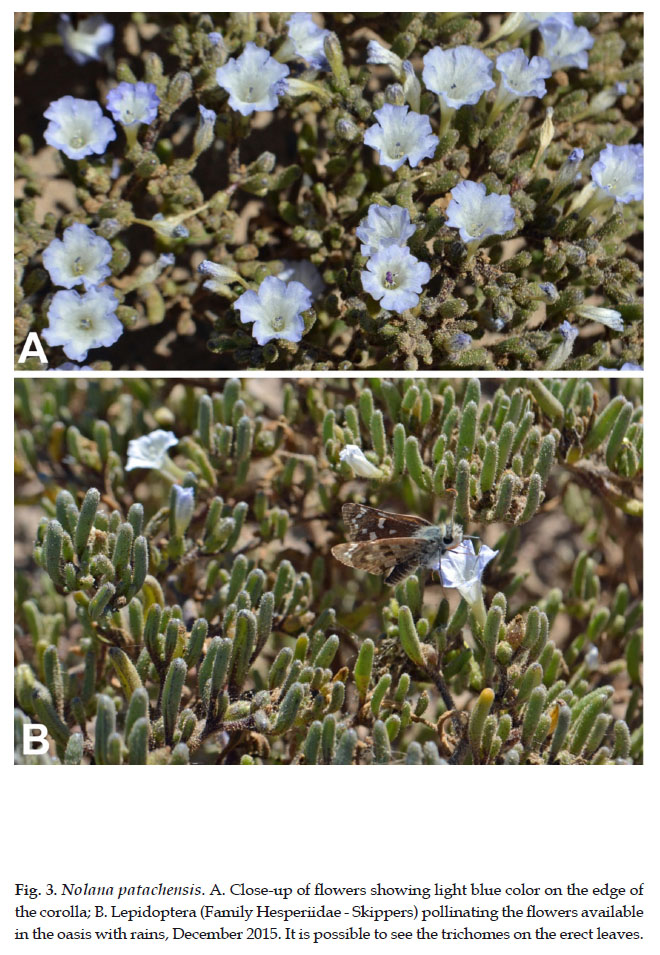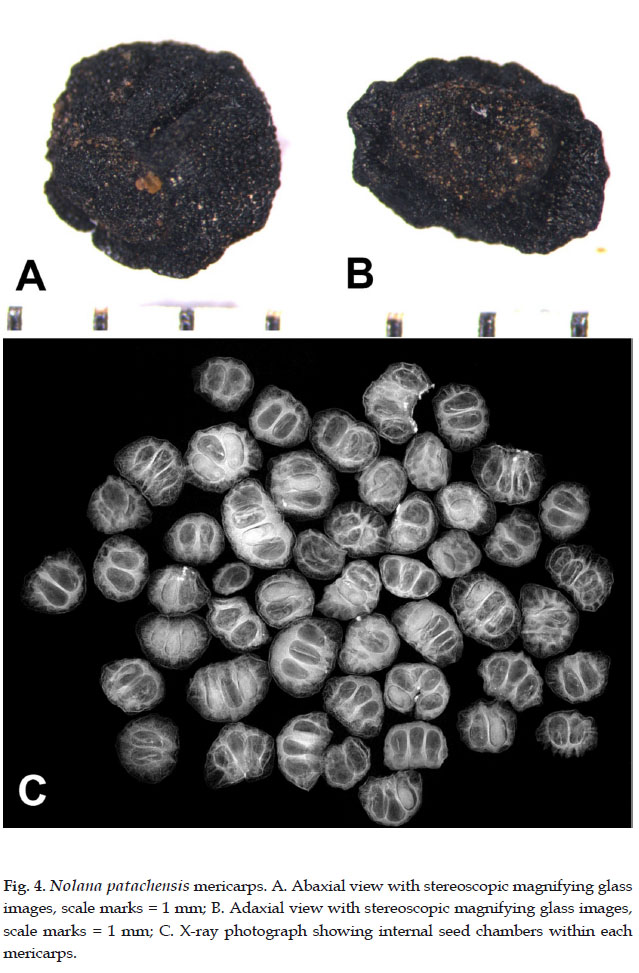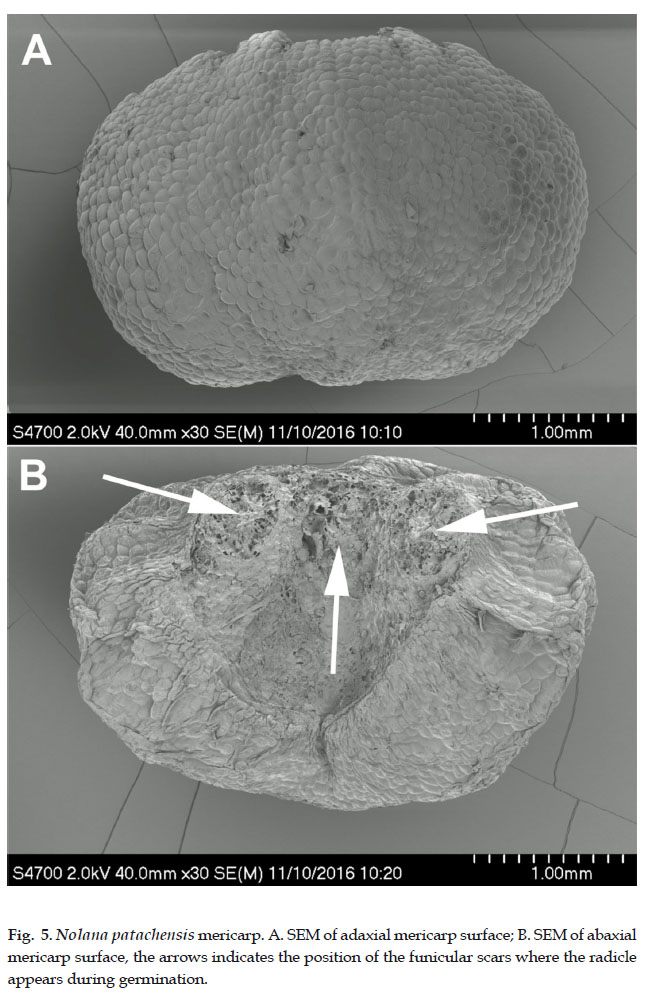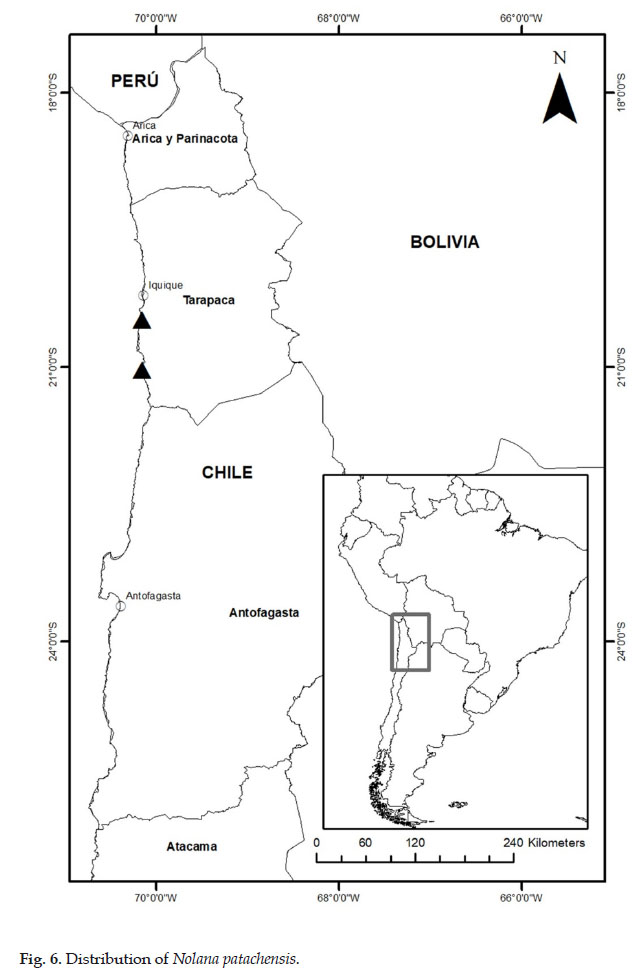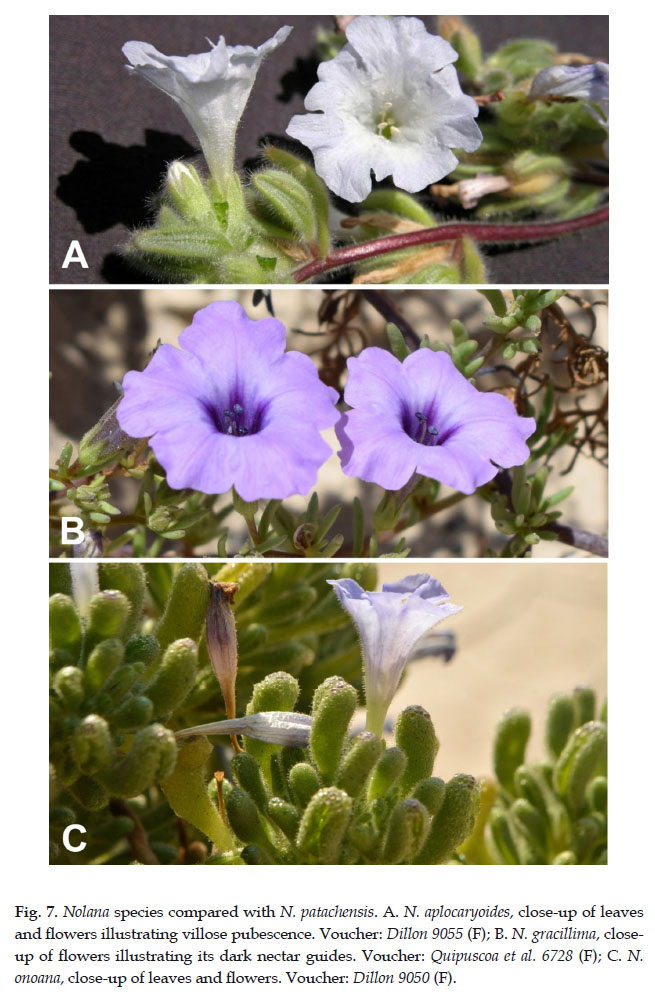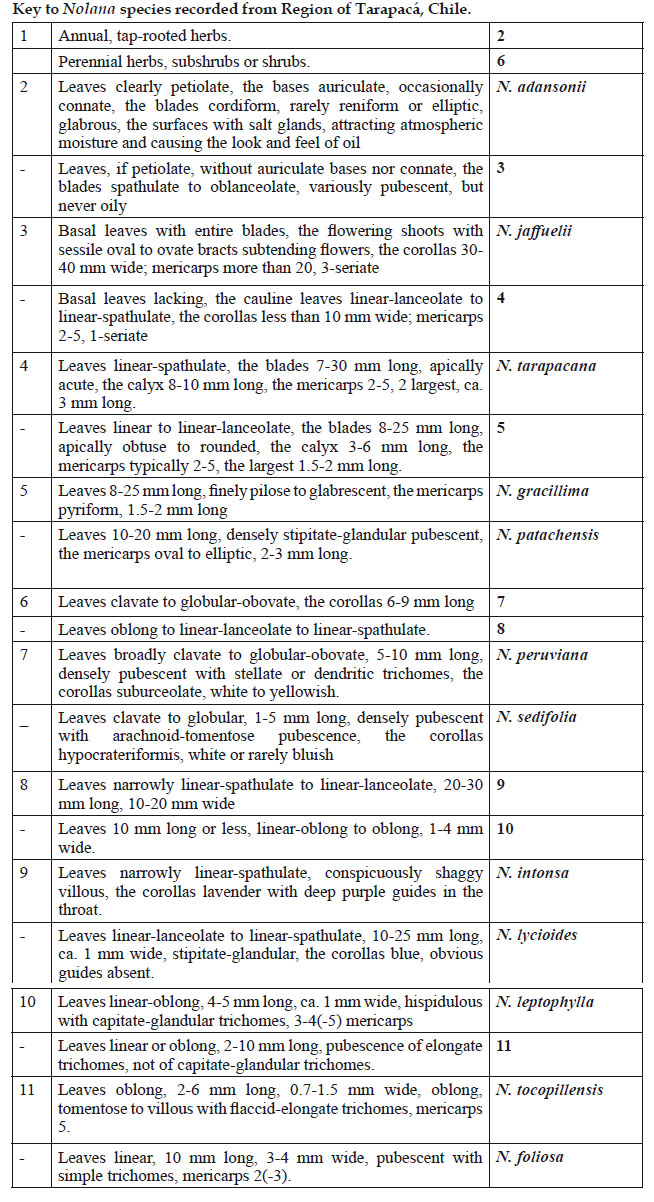Services on Demand
Journal
Article
Indicators
-
 Cited by SciELO
Cited by SciELO
Related links
-
 Similars in
SciELO
Similars in
SciELO  uBio
uBio
Share
Arnaldoa
Print version ISSN 1815-8242On-line version ISSN 2413-3299
Arnaldoa vol.25 no.2 Trujillo mayo/ago. 2018
http://dx.doi.org/http://doi.org/10.22497/arnaldoa.252.25202
Artículos originales
A new endemic species of Nolana (Solanaceae-Nolaneae) from near Iquique, Chile
Una nueva especie endémica de Nolana (Solanaceae-Nolaneae) cerca de Iquique, Chile
Josefina Hepp*, Michael O. Dillon**
* Departamento de Ciencias Vegetales, Facultad de Agronomía e Ingeniería Forestal & Centro del Desierto de Atacama. Pontificia Universidad Católica de Chile, Santiago, CHILE. jnhepp@uc.cl
** The Field Museum, Integrative Research Center, 1400 South Lake Shore Drive, Chicago, IL 60605-2496, USA. mdillon@fieldmuseum.org
Abstract
In connection with studies on the fog oasis or lomas formations at Alto Patache near Iquique, Chile, the first author encountered several Nolana species, including one new to science described here, N. patachensis J. Hepp & M. O. Dillon (Solanaceae-Nolaneae). The new species is diagnosed, described, illustrated with photographs, and compared to nearest geographic neighbors in northern Chile. To an aid in recognition, a key to Nolana species reported from region of Tarapacá is provided. Putative relationships between the various Nolana species encountered at the type locality are discussed. Conservation efforts at the type locality are highlighted, including its unique environmental conditions, biota and potential threats.
Keywords: Nolana, Nolaneae, endemics, lomas formations, new species, region of Tarapacá, Chile, conservation, Solanaceae.
Resumen
En relación a los estudios sobre el oasis de niebla o las formaciones de lomas en Alto Patache cerca de Iquique, Chile, el primer autor recolectó varias especies de Nolana, incluida una nueva especie para la ciencia que aquí se describe, N. patachensis J. Hepp & M. O. Dillon (Solanaceae-Nolaneae). Además de la descripción, se realiza la diagnosis, se ilustra con fotografías y se compara con las especies vecinas más cercanas del norte de Chile. Para ayudar al reconocimiento, se proporciona una clave para las especies de Nolana reportadas para la región de Tarapacá. También se discuten las relaciones putativas entre las diversas especies de Nolana encontradas en la localidad del tipo; así mismo, se resaltan los esfuerzos de conservación en la localidad tipo, incluyendo sus condiciones ambientales únicas, biota y amenazas potenciales.
Palabras clave: Nolana, Nolaneae, endémicas, formaciones de lomas, especie nueva, región de Tarapacá, Chile, conservación, Solanaceae.
Introduction
Nolana L. ex L.f. (Solanaceae-Nolaneae) is a genus consisting of 90 species, including the one described here (Dillon, 2005, 2016). With the addition of this species, it brings the total number to 48 Chilean species, including 45 endemic species, and three species with disjunct distributions ranging from southern Peru (i.e., Nolana adansonii (Roem. & Schult.) I. M. Johnst., N. gracillima (I. M. Johnst.) I. M. Johnst., and N. lycioides I. M. Johnst.). Of this number, twelve Nolana species have been verified from Región de Tarapacá (see Table 1).
In Chile, greatest species diversity in Nolana is confined to near-ocean localities termed lomas formations, between 50-800 m elevation and along the foot of the Coastal Cordillera, usually within 20 kms of the Pacific Ocean (Rundel et al., 1991; Dillon & Hoffmann, 1997). Only a few species are distributed above 2000 m and/or at a distances of 50-500 kms inland from the coast, e.g., Nolana leptophylla (Miers) I. M. Johnst., N. sessiliflora Phil., and N. villosa (Phil.) I. M. Johnst.
Most Chilean species are narrow endemics, with small, restricted geographic ranges and specific ecological requirements, but a few species have larger geographic distributions and occupy several vegetation formations (Dillon, 2005).
Materials and methods
Descriptions were made from dried herbarium specimens deposited in SGO. All acronyms follow those in Index Herbariorum (http://sweetgum.nybg.org/science/ih/). Conservation status was assigned using IUCN criteria (2017) combined with field observations and geographic distribution based on herbarium specimens. Scanning electron microscopy (SEM) was used to examine the structure of the mericarps. Samples were mounted on aluminium SEM stubs and sputter coated with a platinum-gold alloy, using a Quorum Sputter Coater Q150T. Mericarps were examined and photographed using a HITACHI S-4700 SEM at an accelerating voltage of 2.0 kV and working distance of 12.0 mm. Images were saved as TIFF (Tagged Image File Format). Sample were photographed using a stereoscopic magnifying glass.
We utilize the "morphological cluster" concept in recognition of species in Nolana (see Mallet, 1995), defined as "assemblages of individuals with morphological features in common and separate from other assemblages by correlated morphological discontinuities in a number of features". In addition to the diagnoses provided for the new species, specific characters useful in recognition of species are detailed in the Key to Species of Región de Tarapacá, Chile.
Taxonomic treatment
Nolana patachensis J. Hepp & M. O. Dillon, sp. nov. (Figs. 1, 2, 3, 4, 5)
TYPE: CHILE. Región de Tarapacá: Prov. Iquique, Alto Punta Patache, 20°49’S, 70°09’W, 1-XI-1997, W. Sielfeld 32 (holotype: SGO-143057).
Diagnosis
Nolana patachensis is most similar to N. onoana, sharing similar leaf and floral morphology (Fig. 7C); however, it differs from the latter species in its spreading, prostrate habit, and erect, terete leaves. Further, its elliptic or oval mericarps with (1-)2-3(-4) seeds and finely bullate surfaces (Fig. 5A) are essentially unique within its congeners in northern Chile. The mericarps in N. patachensis also differ from mericarps found in N. onoana which are round or spherical, with a finely reticulate or alveolate surfaces. Other annual, tap-rooted species, e.g., N. aplocaryoides, have with much wider leaves with long, villous trichomes (Fig. 7A), and round or spherical mericarps; and N. gracillima with glabrescent to pilose pubescence leaves, shorter corollas (Fig. 7B), and pyriform mericarps.
Description
Taprooted annual herbs to 50 cm in diameter, 10-20 cm tall, basally-branched; stems branched, prostrate to decumbent, to 15 cm long, densely stipitate-glandular. Leaves alternate, sessile, the blades linear-oblong, 10-20 mm long, 3-4 mm wide, terete, erect or perpendicular orientation, succulent, densely pubescence with stout, stipitate-glandular trichomes, entire, apically rounded, the bases rounded. Inflorescences of solitary flowers in upper leaf axils; pedicels cylindrical, densely pubescent, 2-7 (-10) mm long. Flowers 5-merous; calyx narrowly campanulate, 5-7 mm wide at anthesis, densely covered with stipitate-glandular trichomes, 5-lobed, the tube ca. 3-5 mm long, ca. 5 mm wide, the lobes lanceolate, unequal, 2-3 mm long, ca. 1 mm wide, the apices obtuse or rounded; corollas zygomorphic, infundibuliform, 18-24 mm long, 8-12 mm wide at anthesis, distally lavender to light blue, the throat clear, externally and internally glabrous, the lobes obtuse; stamens 5, included, the filaments inserted on lower third of corolla, unequal, 3 long, 2 short, anthers dithecal, purple, the thecae ca. 1.2 mm long, ca. 1 mm wide, glabrous; ovary glabrous, basal nectary ca. 1 mm wide, the carpels 5, the style included, the stigma green. Fruits mericarps, 5, 1-seriate, oval to elliptic, black, 2-3 mm long, 1.5-2 mm wide, adaxial surfaces minutely bullate; seeds (1-)2-3(-4) per mericarp.
Phenology: Annual, tap-rooted annual that responds to sufficient moisture for germination and flowering during november, 1997, and more recently november-december, 2015.
Etymology: The species epithet is the latinisation of the geographic locality of the type collection, Alto Patache fog oasis or lomas formation located in Región of Tarapacá of northern Chile. As with many place names, the origins remain obscure, but it may have its origins in Puquina, a language distantly related to Quechua. In any event, it is not associated directly with either Quechua or Aymara. Further details on the locality are to be found below.
Distribution and ecology: Nolana patachensis has been recorded from two adjacent localities in Región de Tarapacá (Fig. 6), Alto Patache fog oasis or lomas formation (20º48’S, 70º09’W) and Alto Punta Lobos (21º02’W, 70º09’W). Both of these localities exhibit southwest oriented slopes that are constantly exposed to fog (Muñoz-Schick et al., 2001; Calderón et al., 2010; Osses et al., 2017). Alto Patache fog oasis has been recognized as a priority area for conservation and is currently protected in a concession granted by the Ministry of National Assets for 25 years (since 2007) to Pontificia Universidad Católica de Chile, through the Atacama Desert Center. Its isolation has provided conditions for development of a particular biota. For example, it is the only known locality for Santessonia cervicornis (Follmann) Follmann (an endemic Critically Endangered lichen species; Vargas et al., 2017) and several other lichens common to the Atacama Desert. The vascular flora at Alto Patache has been estimated at approximately 42 species of vascular plants (Pliscoff et al., 2017), including one of the few populations of Alstroemeria lutea Muñoz-Schick (Muñoz-Schick, 2000). The arthropod fauna includes two endemic Coleoptera, Scotobius patachensis and Scotobius larraini (Sagredo et al., 2002), and two bees, Penapis larraini (Hymenoptera: Halictidae: Rophitinae) (Packer, 2012) and Neofidelia submersa (Hymenoptera: Apoidea: Megachilidae) (Dumesh & Packer, 2013). Lastly, this locality has been implicated in the first record of a noctuid moth, Hemieuxoa polymorpha Forbes, for Chile, when adults were collected at Alto Patache in 1999 (Angulo & Olivares, 2005). Alto Punta Lobos is located approximately 25 kms south of Alto Patache, and like that formation, it has a compliment of perhaps 20 endemics in a flora of ca. 40 species (Muñoz-Schick et al., 2001).
Putative relationships: Nolana patachensis is distinctive among its congeners in Chile with a combination of characters not encountered in any other described species. While DNA results are not available for this species, overall morphological similarity suggests relationships with Nolana onoana, a member of Clade G (Dillon et al., 2009).
Clade G is a strictly Chilean clade including Nolana aplocaryoides as the sister taxon to the remainder of the clade (Dillon et al., 2009). This group is represented by small to large shrubs and annuals, all with small leaves, (1-)10-20(-40) mm long and (1-)2-5(-7) mm wide, all with smaller corollas when contrasted with those in Clade B (e.g., N. jaffuelii) and some members with only white or yellowish corollas. The leaf pubescence is extremely variable from glabrous to densely canescent with stellate or dendritic, or arachnoid, stipitate, or simple trichomes, and rarely with superficial salt glands.
Conservation status: Critically Endangered (CR); overall distribution at two localities, each with <10 km2 (CR) and perhaps <250 individuals. See IUCN (2017) for explanation of measurements. The threats to these habitats are posed by ever-expanding human pressure from mining and other industrial processes that can contaminate these fragile environments. Efforts at studying, protecting and preserving the region are underway.
Additional specimens examined: CHILE. Región de Tarapacá: Prov. Iquique, Alto Patache, E. Belmonte 97770 (CONC-143484), Alto Punta Patache, 20°49’W, 70°09’W, 800 m, 8-XI-1997, R. Pinto s.n. (SGO-142975); Alto Punta Lobos, 21°02’S, 70°09’W, 800 m, 17 Jan 1998, R. Pinto s.n. (SGO-142976).
A series of Nolana collections from further south of the currently known range of N. patachensis need to be evaluated in the light of recent discoveries; these are from Región de Antofagasta, Prov. Tocopilla, camino a Mina Mantos de La Luna, M. Quezada & E. Ruiz 16 (CONC-121070), M. Quezada & E. Ruiz 17 (CONC-121207), and M. Quezada & E. Ruiz 19 (CONC-121076; SGO-127878). Another collection that should be scrutinized further; Prov. Tocopilla, Quebrada Mamilla, F. Schlegel 7693 (CONC-115627).
Notes: When herbarium material of this plant was first encountered by MOD in 2009, the type sheet had been determined as Nolana aplocaryoides, another tap-rooted annual species typically recorded further to the south. That species has different leaves and pubescence, but with similar corollas (Fig. 7A). At that time, MOD determined the sheets as N. gracillima, a species originally described from southern Peru (Fig. 7B) but with populations reaching northern Chile. In 2018, MOD examined photographs of living plants with flowers taken by JH on a field trip to Alto Patache in 2015, after the abundant August rains in the sector (Figs. 2, 3), MOD recognized the plants as distinct, and convinced that the taxon was new to science. While close to N. onoana (Fig. 7C) in its floral morphology, that species has a very different growth habit and its leaves are more sulcate on the abaxial surfaces, but most distinctive are the differences in the mericarps.
Acknowledgements
We thank the curators and staff at SGO and CONC for permitting examination and photography of collections. Field studies were supported, in part, by grants to JH by CONICYT – Beca Doctorado Nacional (21130176). CONAF (Corporación Nacional Forestal) is thanked for the permits granted to carry out continuous field studies, and also Estación Experimental Atacama UC - Oasis de Niebla de Alto Patache (Pablo Osses) for facilitating the visit to the study site. JH would like to thank Eduardo Contreras and Dr. Horacio Larraín, with whom she traveled in December 2015 to Alto Patache; Dr. Larraín and Pilar Cereceda are specially remembered and JH would like to dedicate this species to them, for their commitment to studies in the desert. Dr. Laurence Packer is acknowledged for help with butterfly identification and appropriate literature. JH acknowledges the support of her thesis committee, including Samuel Contreras, Miguel Gómez, Gloria Montenegro and Pedro León. We thank Victor Quipuscoa (HSP) for critically reviewing the manuscript and providing a digital image of Nolana gracillima (Fig. 7B).
Contribution of the authors
J. H.: Fieldwork, redaction of the text, taxonomic determination of the species, review and approval of the final text. M. O. D.: Redaction of the text, evaluation methodology, fieldwork, taxonomic determination of the species, review and approval of the final text.
Conflicts of interests
The authors declare not to have conflicts of interests.
Literature Cited
Angulo, A. O. & T. S. Olivares. 2005. Hemieuxoa polymorpha Forbes 1933 primer registro para Chile: ¿relicto o dispersión? (Lepidoptera, Noctuidae, Noctuinae) - Hemieuxoa polymorpha Forbes 1933 first record to Chile: ¿relictual or dispersal? (Lepidoptera, Noctuidae, Noctuinae). Gayana 69(1): 144-146. [ Links ]
Calderón, M.; P. Cereceda; H. Larrain; P. Osses; L. Pérez & M. Ibáñez. 2010. Alto Patache fog oasis in the Atacama Desert: Geographical basis for a sustainable development program. In Proceedings of the 5th International Conference on Fog, Fog Collection and Dew, 25–30 July 2010, Münster, pp. 202-206. [ Links ]
Dumesh, S. & L. Packer. 2013. Three new species of Neofidelia (Hymenoptera: Apoidea: Megachiliae) from Northern Chile. Zootaxa 3609(5): 471-483. [ Links ]
Dillon, M. O. 2005. Solanaceae of the Lomas formations of Coastal Peru and Chile. In V. Hollowell, T. Keating, W. Lewis, and T. Croat (eds.). A Festschrift for William G. D’Arcy: The Legacy of a Taxonomist. pp. 131-155. Monographs in Systematic Botany from the Missouri Botanical Garden 104.
Dillon, M. O. 2016. 71. Nolana (Solanaceae). In G.E. Barboza, A.T. Hunziker, G. Bernardello, A.A. Cocucci, A.E. Moscone, C. Carrizo Garcia, V. Fuentes, M.O. Dillon, V. Bittrich, M.T. Cosa, R. Subils, A. Romanutti, A. Arroyo, & A. Anton (eds.), The Families and Genera of Vascular Plants. Asterales. pp. 343-344. Vol. 8. Springer-Verlag, Berlin. [ Links ]
Dillon, M.O. & A. E. Hoffmann-J. 1997. Lomas Formations of the Atacama Desert, Northern Chile. In S. D. Davis, V. H. Heywood, O. Herrera-McBryde, J. Villa-Lobos and A. C. Hamilton (eds.), Centres of Plant Diversity, A Guide and Strategy for their Conservation. pp. 528-535. WWF, Information Press, Oxford, United Kingdom. [ Links ]
Dillon, M. O.; T. Tu; A. Soejima; T. Yi; Z. Nie; A. Tye & J. Wen. 2007. Phylogeny of Nolana (Nolaneae, Solanoideae, Solanaceae) as inferred from granule-bound starch synthase I (GBSSI) sequences. Taxon 54: 1000-1011. DOI: 10.2307/25065900http://www.jstor.org/stable/25065900 [ Links ]
Dillon, M. O.; T. Tu; L. Xie; S. Quipuscoa & J. Wen. 2009. Biogeographic diversification in Nolana (Solanaceae), a ubiquitous member of the Atacama and Peruvian Deserts along the western coast of South America. Journal of Systematics & Evolution 47: 457-476. https://doi.org/10.1111/j.1759-6831.2009.00040.x [ Links ]
IUCN. 2017. The IUCN Red List of Threatened Species. Version 2017-3. <http://www.iucnredlist.org/static/categories_criteria_3_1> Downloaded on 02 March 2018. [ Links ]
Johnston, I. M. 1936. A study of the Nolanaceae. Contributions Gray Herbarium 112: 1-83. [ Links ]
Knapp, S. 2002. Tobacco to tomatoes: a phylogenetic perspective on fruit diversity in the Solanaceae. Journal Experimental Botany 53: 2001-2022. https://doi.org/10.1093/jxb/erf068 [ Links ]
Mallet, J. 1995. A species definition for the modern synthesis. Trends in Ecology and Evolution 10: 294-299. doi: 10.1016/0169-5347(95)90031-4 [ Links ]
Mesa-M, A. 1981. Nolanaceae. Flora Neotropica 26: 1-197. http://www.jstor.org/stable/4393742. [ Links ]
Muñoz-Schick, M. 2000. Novedades en la familia Alstroemeriaceae. Gayana Botánica. 57(1): 55-59. [ Links ]
Muñoz-Schick, M.; R. Pinto; A. Mesa & A. Moreira-Muñoz. 2001. "Oasis de neblina" en los cerros costeros del sur de Iquique, Región de Tarapacá, Chile, durante el evento El Niño 1997-1998. Revista Chilena de Historia Natural 74: 389-405. [ Links ]
Osses, P.; R. Escobar; C. del Rio; R. Garcia & C. Vargas. 2017. El Clima desértico costero con nublados abundantes del desierto de Atacama y su relación con los recursos naturales energía solar y agua de niebla. Caso de estudio Alto Patache (20,5°S), región de Tarapacá, Chile. Revista de Geografía Norte Grande 68: 33-48. [ Links ]
Packer, L. 2012. Penapis larraini Packer, a new species of rophitine bee (Hymenoptera: Halictidae) from a fog oasis in Northern Chile. Zootaxa 3408: 54-58. [ Links ]
Pliscoff, P.; N. Zanetta; J. Hepp & J. Machuca. 2017. Efectos sobre la flora y vegetación del evento de precipitación extremo de agosto 2015 en Alto Patache, Desierto de Atacama, Chile. Revista de Geografía Norte Grande 68: 91-103. [ Links ]
Quipuscoa, S. V. & M. O. Dillon. 2018. Four new endemic species of Nolana (Solanaceae-Nolaneae) from Arequipa, Peru. arnal 25: in press.
Rundel, P. W.; M. O. Dillon; B. Palma; A. H. Mooney; S. L. Gulmon & J. R. Ehleringer. 1991. The phytogeography and ecology of the coastal Atacama and Peruvian Deserts. Aliso 13: 1-50. doi: 10.5642/aliso.19911301.02 [ Links ]
Sagredo, E.; H. Larraín; P. Cereceda; A. Ugarte; P. Osses & M. Farías. 2002. Variación espacio-temporal de la entomofauna de coleópteros en el oasis de niebla de Alto Patache (20º 49` S, 70º 09’ W) y su relación con factores geográficos. Revista de Geografía Norte Grande 29:121-133.
Tu, T.; M. O. Dillon; H. Sun & J. Wen. 2008. Phylogeny of Nolana (Solanaceae) of the Atacama and Peruvian Deserts inferred from sequences of four chloroplast markers and the nuclear LEAFY second intron. Molecular Biology & Evolution 49: 561-573. doi:10.1016/j.ympev.2008.07.018 [ Links ]
Vargas, R.; D.Stanton & P. Nelson. 2017. Aportes al conocimiento de la biota liquénica del oasis de neblina de Alto Patache, Desierto de Atacama.Revista de Geografía Norte Grande 68: 49-64. [ Links ]
Citación: Hepp, J. & M. O. Dillon. 2018. A new endemic species of Nolana (Solanaceae-Nolaneae) from near Iquique, Chile. arnal 25 (2): 323-338. doi: http://doi.org/10.22497/arnal.252.25202
Recibido 20-IV-2018; Aceptado: 28-V-2018; Publicado online: 30-VII-2018; Publicado impreso: 30-VIII-2018















